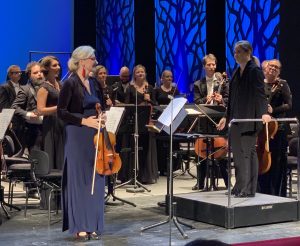The 46th International Viola Congress takes place in Poznan (Poland) from Sept. 24th – 28th, 2019. Your intrepid bloggers Karin Dolman and Kristofer Skaug bring fresh reports daily from this temporary hotspot of the viola universe.
Day 2: Wednesday, September 25th, 2019
<previous day> <next day>
I must be getting old, as attending viola ensemble rehearsal at 8am (a daily session aptly titled “Everyone is Eager“, in the early drafts of the programme) proved to be an impossible challenge this morning, after late-night blogging work. Apparently 3 die-hards showed up… but I’m not too ashamed, because without that extra sleep I would have been unconscious at this point, unable to complete this blog in time. Hang on for the full report of a very long and action-packed day…!
The 9am lecture session kicked off with a “food-for-thought” session by Myrna Layton (representing the Primrose International Viola Archive – PIVA) with the title “Building your public: attracting and retaining the Millenial and iGen(eration) audience“. She started out elaborating a number of thesis statements:
- Performers needs to build an audience if they want to have an audience
- Players need to ask themselves about their relationship to their audiences
- All musicians should be able to address audiences confidently
- Understanding the “iGen” means understanding the future (audience)
As a result, a “list of things to think about” emerged, however it remains more a list of questions than ready-served answers (that would be too easy!). I wonder if we can figure out how the iGen audiences work before the next hard-to-reach generation emerges…!
Next up was an interesting presentation by Elyse Dalabakis, concerning the viola concerto by the Greek composer Dimitris Dragatakis. This is part of her Ph.D. research under guidance of prof. Donald Maurice, in Wellington (NZ). She travelled to Athens to perform archive research for this work, and was also introduced to Artur Paciorkiewicz, the Polish violist who did the premiere performance and recording in 1993.
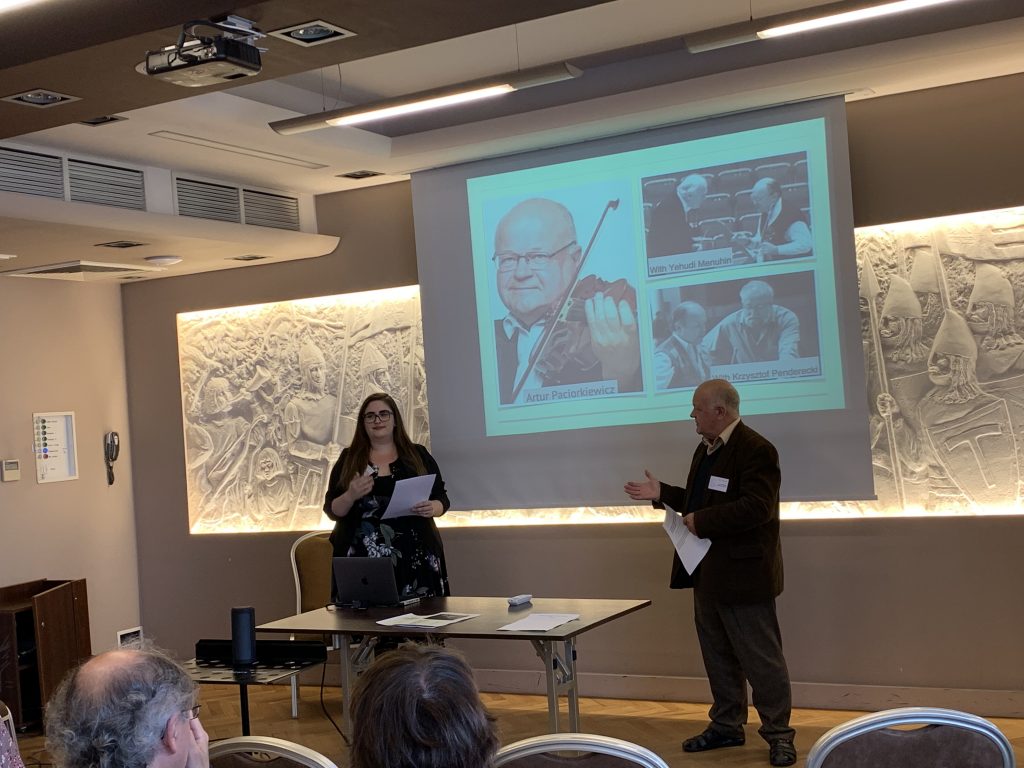 By no coincidence whatsoever, mr. Paciorkiewicz was present in the room, and was subjected to a (prepared-translation) interview about the process of rehearsing and performing this work. The composer (Dragatakis) was apparently unusually pleased with the premiere performance, the first movement of which we were given to hear the actual recording (reportedly a premiere sounding as such). It is indeed a fascinating work!
By no coincidence whatsoever, mr. Paciorkiewicz was present in the room, and was subjected to a (prepared-translation) interview about the process of rehearsing and performing this work. The composer (Dragatakis) was apparently unusually pleased with the premiere performance, the first movement of which we were given to hear the actual recording (reportedly a premiere sounding as such). It is indeed a fascinating work!
At 10am we hurried over to the POSM recital hall, where Maxim Rysanov was giving a master class. The DVS “Sister Act” (Sunniva and Ursula Skaug) were fortunate to go first, with a half-hour lesson on the Lutoslawski Bucolics. He easily squeezed out some extra mileage in dynamics, phrasing, tempi, and even re-arranging the octave choices in various places. After this there were some very interesting lessons on the Bach solo suites, the names of the students unfortunately escaped me.
The programme “An oriental bridge” by Baris Kerem Bahar (Turkey) featured various solo viola pieces written mostly for (and even by) himself. On the whole his compositions are neither modern in style nor very virtuosic, but quite sweet and melodic music (quote: “I’m a romantic guy!”). The ornaments and sounds are really oriental, but with a very classical trained scale work.
Unfortunately, he was unable to perform his programmed pieces by Tsintsadze and Khachaturian, because there was no pianist (wtf 1st degree). Instead he took more time for a Q&A session, and told us about an emerging genre referred to as “Turkish classical music”, which bridges traditional oriental and classical styles, making a specific use of e.g. vibrato, sul tasto, ponticello, and quarter-tone adjustments on conventional scales. For more information you can visit his website: www.bariskerembahar.com
The Swiss IVC delegation summed up in one person, Viacheslav Dinerchtein brought an interesting lecture-recital about Mieczysław Weinberg’s solo sonatas for viola. Born in a Polish-Jewish family in pre-WW2 Warsaw, the talented pianist Weinberg fled (as only survivor of his family) when the German invasion came, and ended up in Minsk (Belarus), where he entered the Conservatory. Particularly notable is his discovery of, and eventual friendship with Shostakovich. They were both very prolific composers, and it seems clear that they influenced each other musically. Case in point, Dinerchtein postulated with confidence that Fjodor Druzhinin’s performance of Weinberg’s viola sonatas must have given Shostakovich the spark to write his own viola sonata. In the other direction, Shostakovich fervently and publicly defended Weinberg’s music against bans and official State beratements.
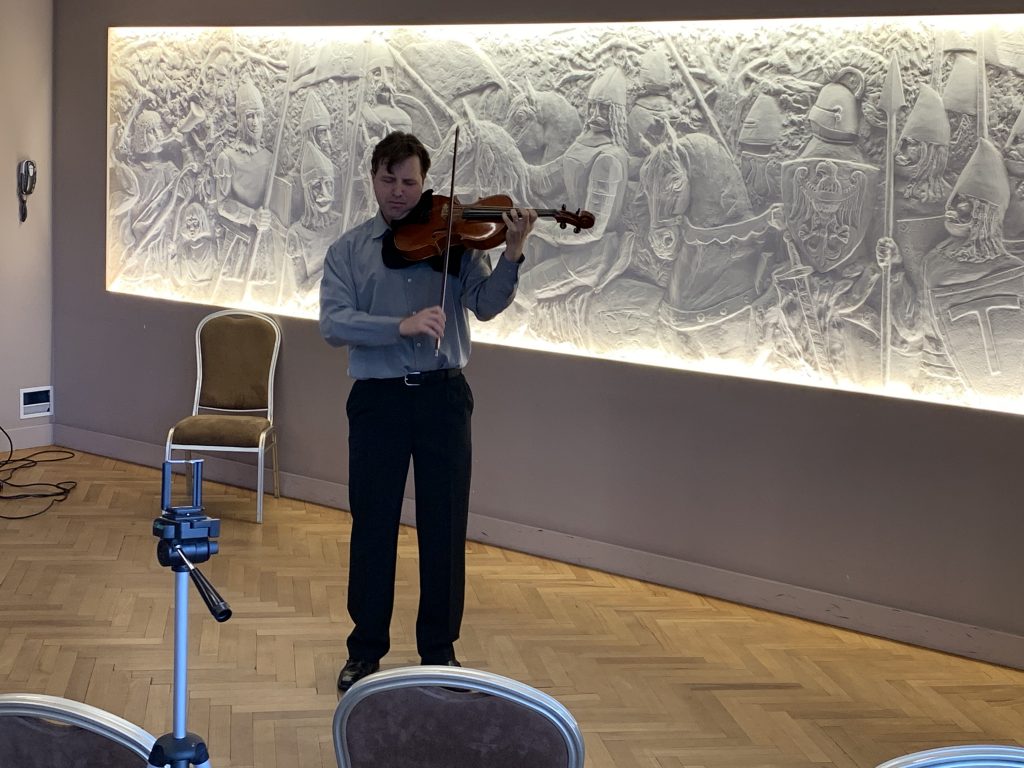 Dinerchtein played the 1st Weinberg solo sonata for us by heart (!), a very complex work, and deeply impressive. I (Karin) definitely could hear the influences of Shostakovich here, but I also felt a touch of Britten – one of his string quartets sounds nearly like a quotation from this Weinberg viola solo sonata.
Dinerchtein played the 1st Weinberg solo sonata for us by heart (!), a very complex work, and deeply impressive. I (Karin) definitely could hear the influences of Shostakovich here, but I also felt a touch of Britten – one of his string quartets sounds nearly like a quotation from this Weinberg viola solo sonata.
Lunch break – so we eat our lunchbag sandwiches, with not-too-cheap coffee from the Hotel Ikar restaurant. Outside it has started raining, quite a lot actually. So we’re happy to stay inside and visit the stands at Music4Viola and Gems Music publishers, where lots of interesting repertoire for viola ensembles is on display. We end up buying a healthy stack of fresh sheet music, for further enjoyment at home 🙂
After the break, Aneta Dumanowska and Barbara Papierz performed (as “teacher-student” duo) the Lament for two Violas by Frank Bridge, bringing out some pleasing whole-bodied confluences of sound, which are richly latent in this possibly most famous piece of the viola duo repertoire. It is nearly a symphony in itself, well written technically for the viola, a delight to play and also today to listen to.
Next, Annette-Barbara Vogel and Jutta Puchhammer-Sedillot take on the Sonata for violin and viola (1945) by Mario Castelnuovo-Tedesco (1895-1968): A piece with significant challenges in articulation and sound production. Not to be taken lightly!
1st movement (con brio) is very cheerful and bright. It made me (Karin) think of Reger’s trios for flute, violin and viola – even in dynamics. Then there are also the Rolla–isms, i.e. violin and viola happily agreeing about everything.
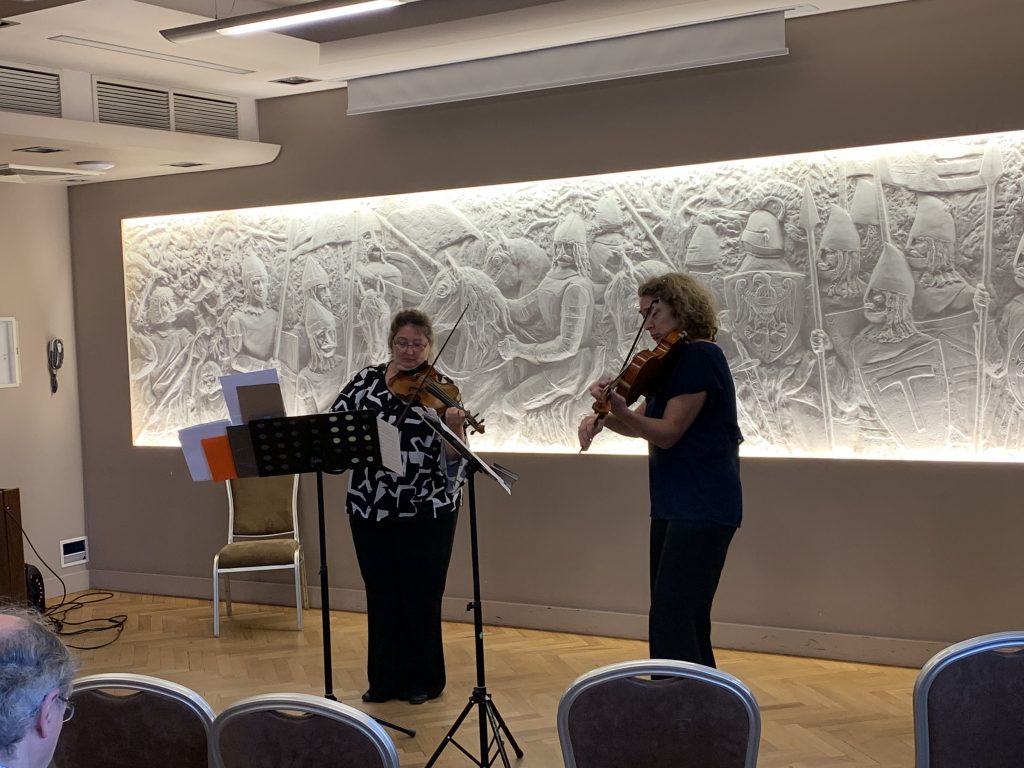 The 2nd movement introduces a more reflective theme, which is fed into a series of variations. The interplay of violin and viola voices is varied and imaginative. The melody initially stays in the viola, and the violin adds Schubertian high variations. And then suddenly this beautiful waltzer followed by an heroic theme in both instruments accompanied by daunting arpeggios. The movement ends with a rich fugue (reminding us why we have to practice thirds!). Beautiful!
The 2nd movement introduces a more reflective theme, which is fed into a series of variations. The interplay of violin and viola voices is varied and imaginative. The melody initially stays in the viola, and the violin adds Schubertian high variations. And then suddenly this beautiful waltzer followed by an heroic theme in both instruments accompanied by daunting arpeggios. The movement ends with a rich fugue (reminding us why we have to practice thirds!). Beautiful!
The ensuing virtuosic Scherzo – Rondo movement is very enjoyable music (an intersection of waltzer and tarantella), and very well played too!
An extra cheer from the crowd: The Portuguese delegation has finally arrived, after a harrowing double-delayed travel of 26 hours without sleep! And just in time for Jorge Alves to bring his contribution to this recital: Two contemporary viola solo pieces. The first piece, Dedans-Dehors by Miguel Azguime (b. 1960), is anchored in deep accentuated E-notes on the C-string, with excursions through glissandi and harmonics all over the place, full of surprising twists. It evokes a feeling of timelessness…
The next work by Armando Santiago (b.1932) bears the title “Neume III, en huit strophes” (the programme booklet had it badly misspelled). The music is challenging for the performer as well as the listener: Likened to “a crazy person talking”, there are undulating, shifting notes and odd, erratic pizzicato outbursts, as well as movements hard to describe with words, except perhaps “you had to be there“…
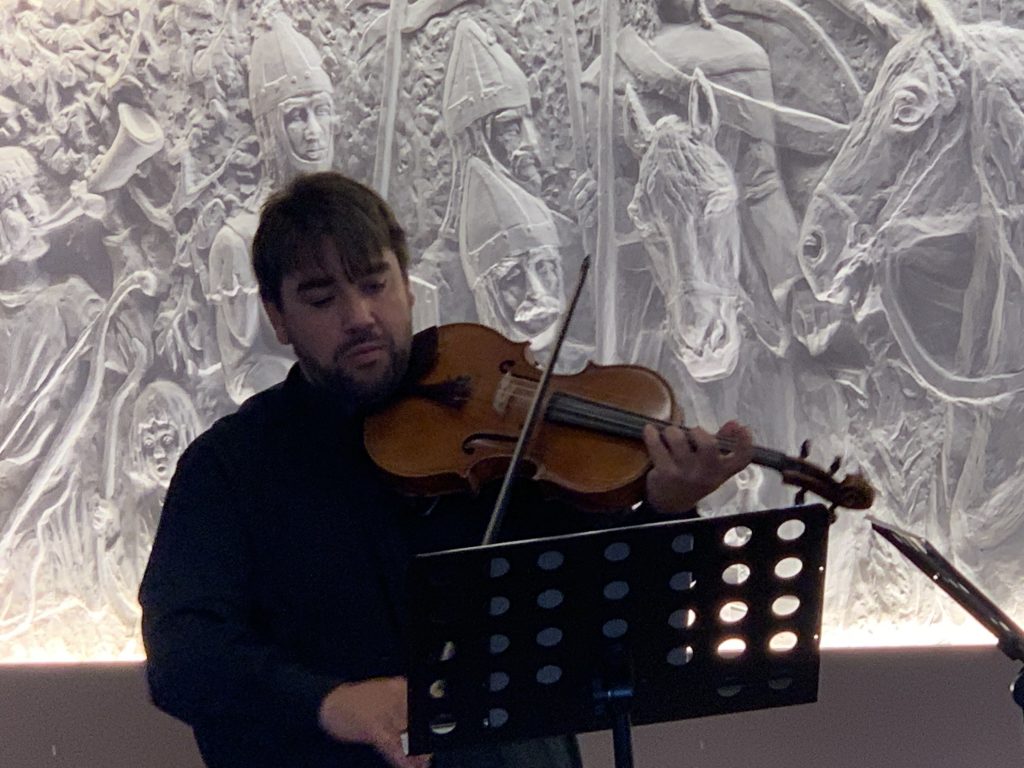 Following a rather wet walk through historical downtown Poznan, we entered the house of the Henryk Wieniawski Music Society, in an alley behind the beautiful Market square. There’s a living-room concert venue with an old white Calisia grand piano (glad there aren’t more IVC attendees, as they would have had to listen outside, in the rain!).
Following a rather wet walk through historical downtown Poznan, we entered the house of the Henryk Wieniawski Music Society, in an alley behind the beautiful Market square. There’s a living-room concert venue with an old white Calisia grand piano (glad there aren’t more IVC attendees, as they would have had to listen outside, in the rain!).
Due to the transit time, we unfortunately missed the lecture about the viola compositions of Tadeusz Paciorkiewicz, but we were on time to hear his viola sonata being executed by Błażej Maliszewski (with Paweł Rydel on the white piano stool).
The next program concerns classical cello sonata transcriptions. Prof. Leszek Brodowski explained his affinity to transcriptions by the shortage of (readily available) viola solo repertoire when he graduated from conservatory, 40 years ago; so he started writing his own transcriptions of classical works – Mozart, Mendelssohn, Schubert. He then performed a transcription of Beethoven’s Cello Sonata op.5 no.2 in g minor, which indeed sounded like a very convincing option for viola – not least by the visible pleasure that prof. Brodowski took in playing Beethoven here, in this chamber music room, where the spirit of Wieniawski is all around.
Krzysztof Komendarek-Tymendorf followed suit with his very own transcription of Brahms’ Cello Sonata no.1 op.38 in E minor. Together with pianist Mirosława Sumlinska he brought the “transcription” themed concert to a very passionate culmination. Unrelated to the skilled performance, however, one can’t help missing Brahms’ powerful cello notes deep down. Tymendorf’s proverbial encore was an actual world premiere of the piece “Waldteufel und Nixe” by Artur Andrzejewski, more of a miniature, tonal in construction in spite of the 1965 birth year of the composer. Very enjoyable – and noted on the wishlist!
Tymendorf’s proverbial encore was an actual world premiere of the piece “Waldteufel und Nixe” by Artur Andrzejewski, more of a miniature, tonal in construction in spite of the 1965 birth year of the composer. Very enjoyable – and noted on the wishlist!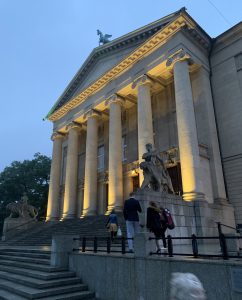
This leaves us with 90 minutes of rest for the ears, and other restorative activities, before we head to tonight’s evening concert in the Poznan Grand Theatre, a quite spectacular building and beautiful opera/concert hall. The Poznan Grand Theatre Symphony Orchestra has taken the stage, with Katarzyna Tomala-Jedynak at the baton. No less than FOUR concertos are programmed, 2 solid hours of viola concertos binge-listening without an intermission! OMG…
Aft er a short welcome and introduction from our hosts as well as IVS president Carlos Maria Solare (“what’s-all-this-Viola-Congress-stuff-then?”, for the broader audience), we are all set for the Anton Wranitzky double-concerto in C, with grand old man Jerzy Kosmala playing together with his own 17-year-old grandson (!) Stefan Kosmala-Dahlbeck. Although both are currently living in the U.S., their roots in Poland are strong.
er a short welcome and introduction from our hosts as well as IVS president Carlos Maria Solare (“what’s-all-this-Viola-Congress-stuff-then?”, for the broader audience), we are all set for the Anton Wranitzky double-concerto in C, with grand old man Jerzy Kosmala playing together with his own 17-year-old grandson (!) Stefan Kosmala-Dahlbeck. Although both are currently living in the U.S., their roots in Poland are strong.
The second concerto on the programme this evening was composed in 2016 by the young Ewa Fabiańska-Jelińska (b.1989), and performed by our congress co-host Ewa Guzowska. It is a refreshing contrast to the Wranitzky concerto, and Guzowska adds a lot of energy to the performance, with beautiful tone qualities. Her viola speaks easily through the string orchestra accompaniment.
Similarly for viola and strings is the concerto by Marek Stachowski, interpreted by Tomasz Rosinski. The latter is audibly and visibly a first-rate violist, but the “script” he gets to work with is a bit on the meager side here. There is significant repetition, long periods of soloist inactivity, and not enough material to keep things cooking for the (too long) duration of the piece.
The opposite would be true for the 1968 concerto of Grażyna Bacewicz (mentioned in yesterday’s blog): in the hands of violist Paweł Riess, and joined by a fully instrumented symphony orchestra (except – oddly, the viola section is vacated!), this piece turns into a truly impressive work. The slow movement is of great beauty, and the finale is explosive and furious. Compliments to the soloist, conductor, and the orchestra alike!
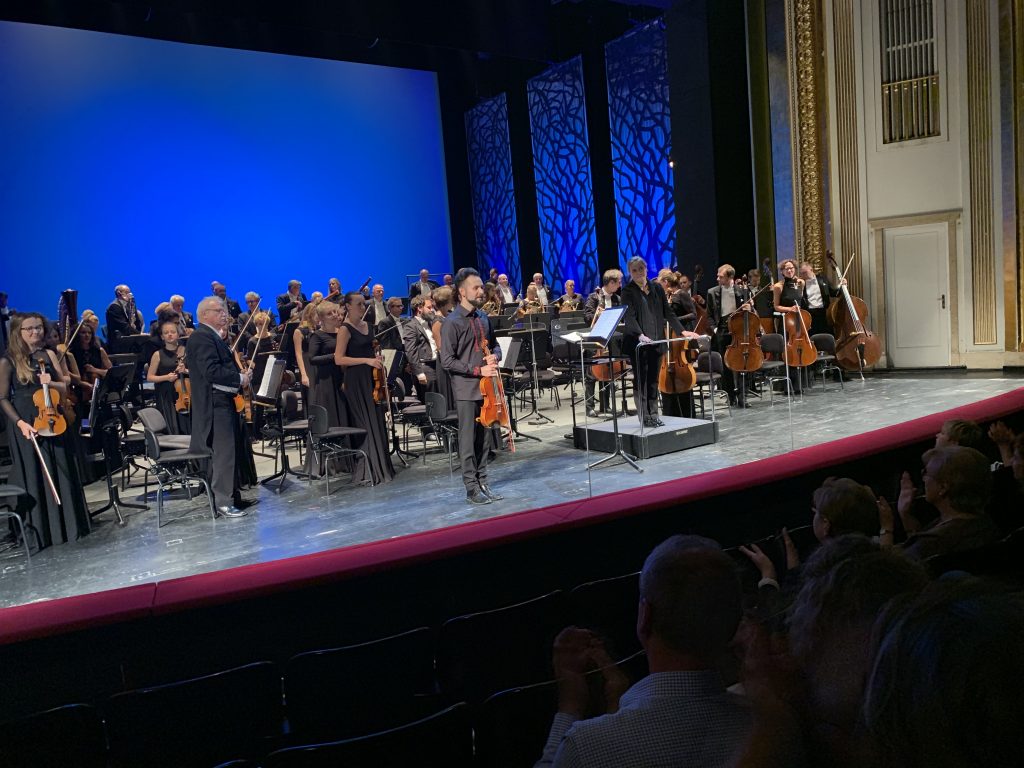 I could say more, but this blog is already long enough, and I am really Eager to make it to Viola Ensemble practice tomorrow at 8am!
I could say more, but this blog is already long enough, and I am really Eager to make it to Viola Ensemble practice tomorrow at 8am!
So that’s it folks – tune in again tomorrow…
– Karin & Kristofer
<next day>

